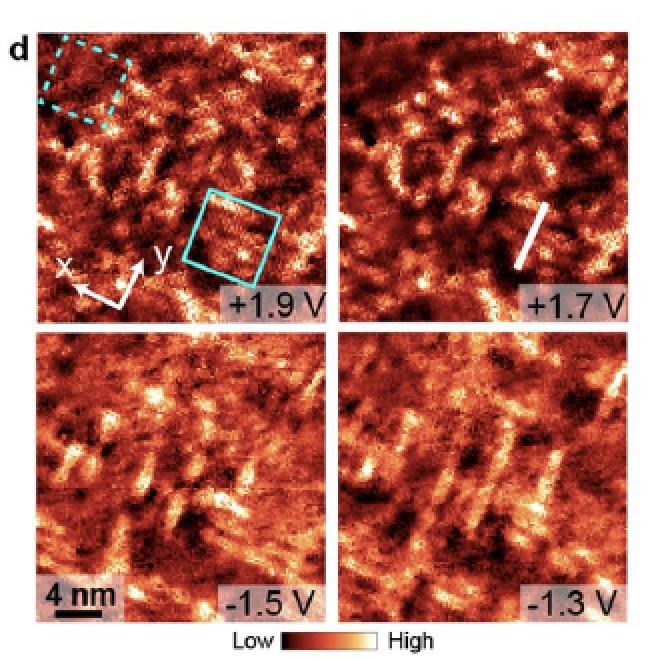Researchers observe charge-stripe crystal phase in an insulating cuprate

Scanning tunneling microscopy was used to analyze a cuperate high-temperature superconductor modified into an insulating state by a team of researchers from Boston College and Brookhaven National Laboratory. Credit: Nature Materials
Researchers from Boston College and Brookhaven National Laboratory have succeeded in modifying a cuprate high-temperature superconductor material into an insulating state, where they found an exotic liquid crystal phase.
The observation of a so-called “charge-stripe” crystal phase was the first of its kind in the cuprate, part of a class of materials referred to as Mott insulators, the team reports today in the journal Nature Materials.
The absence of free charge carriers denotes the material as “undoped.” The process of doping introduces charge carriers and theorists have held that when doped, a cuprate would see the charge carriers order and form liquid crystal phases marked by periodic “charge-stripe” patterns. Such patterns have thus far only been experimentally observed in the superconducting state, said lead author Boston College Assistant Professor of Physics Iilja Zeljkovic.
Zeljkovic and the team, which included members of his lab, Boston College Professor of Physics Ziqiang Wang, and researchers from Brookhaven National Laboratory in New York, used a new methodology to induce the charge ordering in the insulating state, they report in the article, titled “Charge-Stripe Crystal Phase in an Insulating Cuprate.”
The team applied a method of surface annealing, a head treatment used to alter the physical and chemical properties of metals, Zeljkovic said. The process allowed the team to extend the accessible doping range in the cuprate, composed of bismuth, strontium, calcium, copper and oxygen.
Accessing new regions of the material, the team achieved a “lightly doped, charge-transfer insulator state,” Zeljkovic said.
The team analyzed the insulating state at the atomic level using scanning tunneling microscopy and spectroscopy at liquid helium temperatures.
“Our measurements reveal the emergence of a unidirectional charge-stripe order with a wave-length of exactly 4 atomic lattice constants,” Zeljkovic said. “Our data also proves that lightly-doped cuprates have a tendency to form stripes over the bidirectional 'checkerboard' order, thus resolving the long-standing controversy in the field that could not be settled using the existing data on higher-doped samples.”
Zeljkovic said he and his colleagues would like to next explore the relationship of the observed charge ordered phase and the charge ordered phases observed in the superconducting state.
The discovery raises the question of whether the “spin” of charge carriers also orders into periodic patterns, forming so-called spin-density waves, Zeljkovic said.
Media Contact
More Information:
http://dx.doi.org/10.1038/s41563-018-0243-xAll latest news from the category: Materials Sciences
Materials management deals with the research, development, manufacturing and processing of raw and industrial materials. Key aspects here are biological and medical issues, which play an increasingly important role in this field.
innovations-report offers in-depth articles related to the development and application of materials and the structure and properties of new materials.
Newest articles

Properties of new materials for microchips
… can now be measured well. Reseachers of Delft University of Technology demonstrated measuring performance properties of ultrathin silicon membranes. Making ever smaller and more powerful chips requires new ultrathin…

Floating solar’s potential
… to support sustainable development by addressing climate, water, and energy goals holistically. A new study published this week in Nature Energy raises the potential for floating solar photovoltaics (FPV)…

Skyrmions move at record speeds
… a step towards the computing of the future. An international research team led by scientists from the CNRS1 has discovered that the magnetic nanobubbles2 known as skyrmions can be…





















